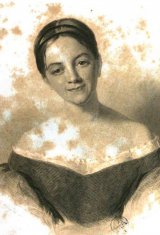Analysis of The Kylas, Caves of Ellora
Letitia Elizabeth Landon 1802 (Chelsea) – 1838 (Cape Coast)
The East, it is thy birth-place, thou bright sun;
There, too, the mind of man first felt its power,
And did begin its course. These mighty fanes
Were of its earliest efforts: that fine skill
And high imagination, which called forth
These giant temples, have, in other shapes,
Gone forth to civilize the world—oh! sun,
Still following in thy track, and, like thy light,
Leaving thick darkness when it past away.
All things are signs in nature, still there are
Subtle analogies we dimly trace.
Perhaps our moral world has but its day,
Of which the great sun is the glorious type;
And intellect will run its course, and set.
If so, we touch on the extremest verge
Of our horizon ; and our arts, our power,
Our conquests o’er the many realms of mind,
Wealth, painting, sciences, and poetry,
Are but that rich magnificence of hues
Which heralds in the closing of our day.
These giant fabrics were the first great signs
Of man's dominion o’er his mother earth:
We have had other triumphs, have achieved
Victories o’er all the other elements;
And having run mankind's appointed race,
Perchance the night comes on, and what we deem
Meridian is our setting.
Lord Mimster, in his “Overland Journey from India,” observes, when speaking of his visit to the Caves of Ellora—“I felt a sensation of gratitude, and almost of esteem, towards the religion which had effected a labour so immense and so remarkable. Every thing around me spoke of other times, of individuals, nations, and arts long since past away; and I took a hurried view of the present state of India, looking in vain for any power or class of men, great, or I may almost say omnipotent enough, to venture on so prodigious an undertaking.” — — —“As I stood in Keylas, casting a rapid glance from those ages concealed in impenetrable darkness, in which the stupendous monuments of art before me had arisen, down to the present moment, I sought in vain for any incident in the lapse of time, which could convey an equal conception of the power of man over matter.” The writer might well proceed to ask, “Whether the object of amazement, next to this, in the history of India, was not that of the inhabitants of an island in the outskirts of Europe, unknown even by name in these regions, till they were first seen as merchants, and then as conquerors; and who, during little more than half a century, had, by a gradual extension of military operations, established over the country an influence or dominion which may now be said to be universal.”
| Scheme | ABCXXCAXDXCDXXXBXXCDCXXCCXX X |
|---|---|
| Poetic Form | |
| Metre | 0111111111 11011111110 0101111101 01110010111 010010111 1101010101 111100111 11000110111 1011011101 1111010111 1001001101 01101011111 11011101001 010111101 11111011 11001001011010 1011010111 1101000100 1111111 11000101101 1101000111 1101011101 1111010101 10011010100 0101110101 0101110111 010011010 110110101100011101110101111100101100110101001011010011010101001001011111011010010011110101101011010111001001110101111111111010001110110101100111011001011110010010001001001010011011101011010101101110100001111101110010101011101001011011110010101011100100110011110010011100011100110110110110111100111000110101110100110100010110001001010010110010101111111010 |
| Characters | 2,502 |
| Words | 444 |
| Sentences | 12 |
| Stanzas | 2 |
| Stanza Lengths | 27, 1 |
| Lines Amount | 28 |
| Letters per line (avg) | 70 |
| Words per line (avg) | 16 |
| Letters per stanza (avg) | 981 |
| Words per stanza (avg) | 222 |
Font size:
Submitted by Madeleine Quinn on August 16, 2016
Modified by Madeleine Quinn on October 19, 2019
- 2:13 min read
- 92 Views
Citation
Use the citation below to add this poem analysis to your bibliography:
Style:MLAChicagoAPA
"The Kylas, Caves of Ellora" Poetry.com. STANDS4 LLC, 2024. Web. 28 Apr. 2024. <https://www.poetry.com/poem-analysis/45105/the-kylas%2C-caves-of-ellora>.


Discuss this Letitia Elizabeth Landon poem analysis with the community:
Report Comment
We're doing our best to make sure our content is useful, accurate and safe.
If by any chance you spot an inappropriate comment while navigating through our website please use this form to let us know, and we'll take care of it shortly.
Attachment
You need to be logged in to favorite.
Log In